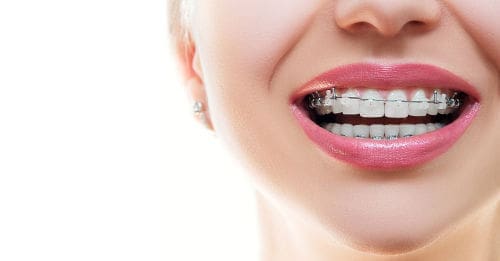Proudly serving Newton MA and surrounding towns.
There are more types of braces available today than ever before. Even if we may not offer every type of braces at our office, understanding how each one works can help our patients make an educated decision about the best type of orthodontic therapy for themselves or their children.
Here are some of the most common types of braces in Newton that are currently available and how each one works:
Traditional Braces
Conventional orthodontic appliances are the “bracket and wire” systems that you’re used to seeing on most people. Modified over the decades, traditional braces are safe and effective on all ages and tooth misalignment needs. From minor crowding to complex orthographic reconstruction, treatment is both predictable and efficient.

Invisalign and Clear Aligner Braces
Translucent aligners are most popular with adult and teen orthodontic patients. These nearly-invisible trays are made from rigid BPA-free plastic and snap snuggly over your teeth. Each set of aligners is digitally mapped using 3D CAD/CAM software to virtually predict and plan your tooth movement on a biweekly basis. Simply change out the aligners as prescribed to straighten your teeth over the course of your case. Invisalign has been used for over 20 years and is extremely reliable.
Ceramic Braces
Cosmetic braces are almost the same as traditional braces, except they’re made out of tooth-colored or ceramic materials. Even the arch wires between your teeth can be fabricated out of low-profile products. The more discrete color of the brackets makes them less noticeable during everyday conversations. Although you can see them from up close, ceramic braces are a perfect “go between” when it comes to a cross between conventional appliances and a removable orthodontic system. Especially if you have a more moderate to complex case that may not fit into a typical clear aligner criteria.
Lingual Braces
In dentistry the word “lingual” refers to the tongue-side surfaces of teeth. Lingual braces, for instance, are orthodontic appliances that are bonded to the tongue-sides of teeth instead of the surfaces facing the cheeks. Sometimes referred to as “invisible” braces, these systems are hidden from everyone else because of their low-profile position. They can take a bit of time to adjust to and be more challenging to clean on a day-to-day basis. Due to their nature, lingual braces aren’t used as frequently as more mainstream types of appliances on the market.
“Accelerated” Braces
Short-term orthodontics or cosmetic braces are used when your overall bite is relatively aligned, but the front teeth are slightly out of place. Perhaps you have minor crowding or gaps in your smile zone that you want to address. Instead of straightening your entire arch (which requires more time) only the front teeth are adjusted. This modified care plan requires less time, being that fewer teeth are involved. A typical accelerated braces treatment may only take 3-6 months.
Phase I & Phase II Braces / Early Interceptive Orthodontics
Sometimes children require early orthodontic intervention. These interceptive treatments work to correct potential growth issues, such as a short jaw, narrow palate, impacted teeth, or spacing issues. By completing “phase I” of treatment while your child’s mouth is still developing, growth patterns can be modified, and potentially serious orthodontic concerns (including surgery) avoided in the future. This stage of treatment typically takes place around age 7 or 8. Once your child is older, we initiate “phase II” of the treatment to fine tune their final adult tooth alignment.
Orthodontic Appliances
Certain types of orthodontic therapy are completed without or alongside of braces. For instance, a palatal expander or Herbst appliance may be necessary to create appropriate room for your child’s teeth to line up properly. Or a removable device can be worn to potentially avoid the need for braces in the future. These types of appliances can also include things like space maintainers or interim devices that are semi-permanently attached to the teeth (such as “tongue trainers”).
Learn More
More often than not, you’ll qualify for at least a couple of different types of braces. Working with an experienced orthodontic provider can help you determine the best route of care for your unique smile. Especially if you’re interested in a cosmetic option, like Invisalign.
Contact Waban Dental Group at (617) 527-6061. We happily accept new patients and many insurances.





